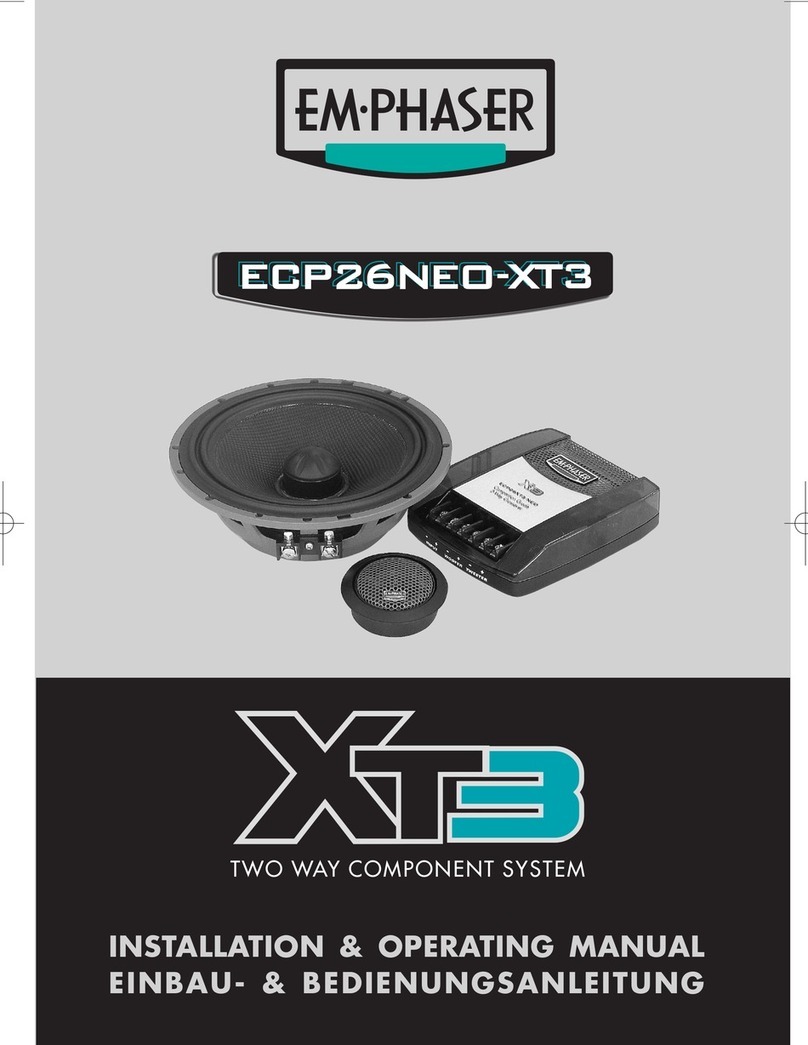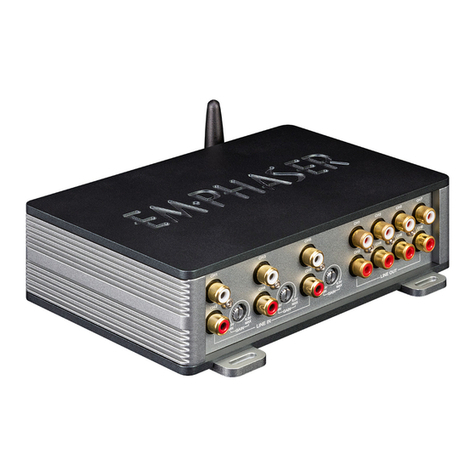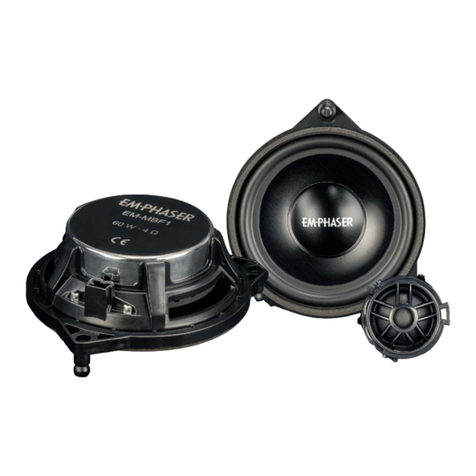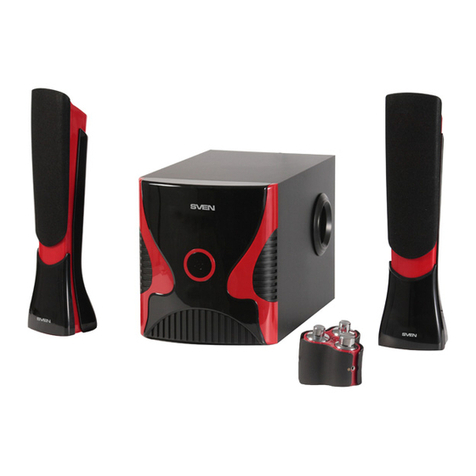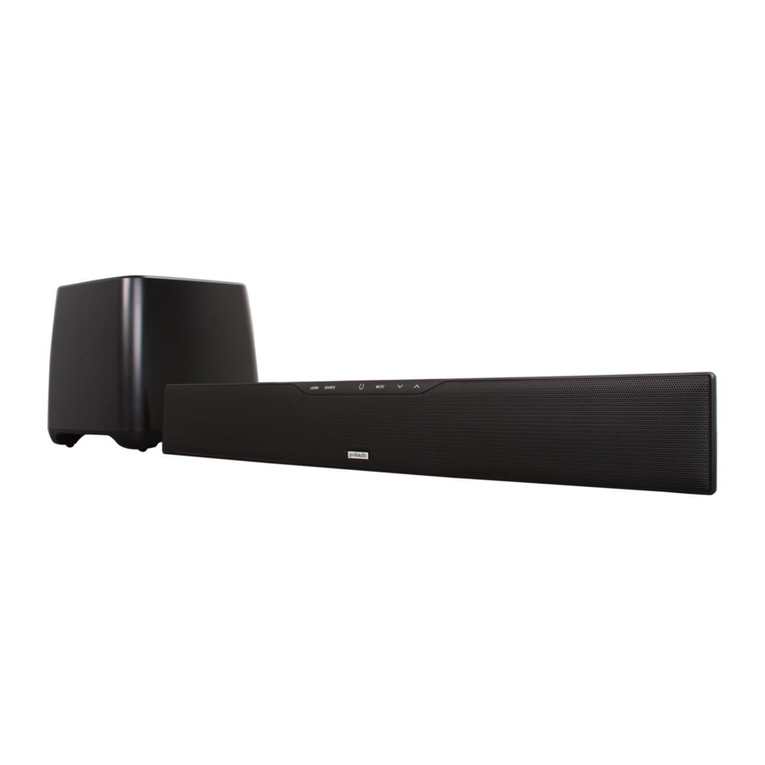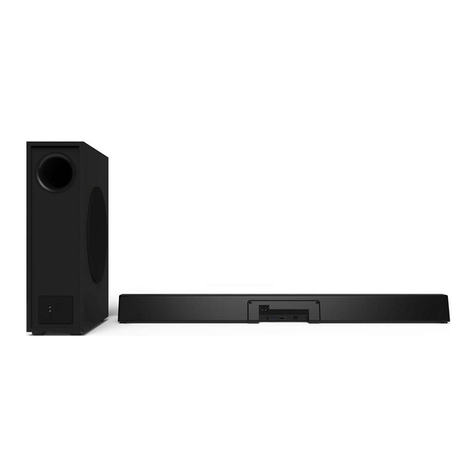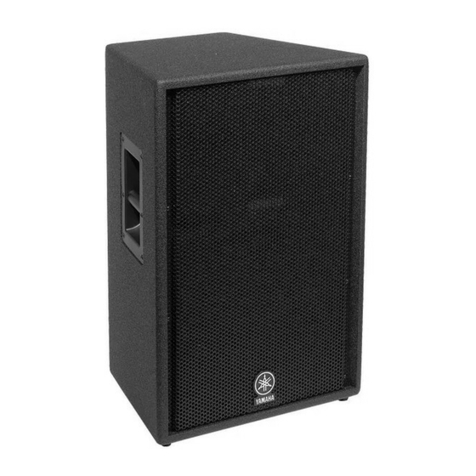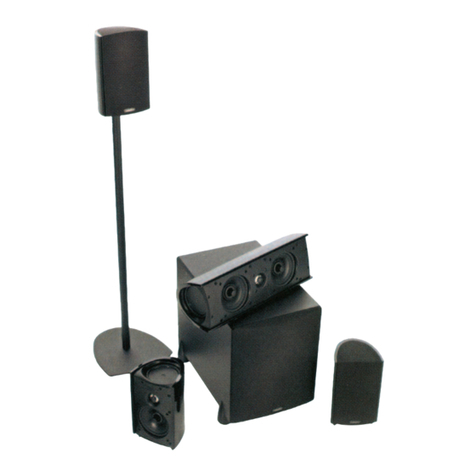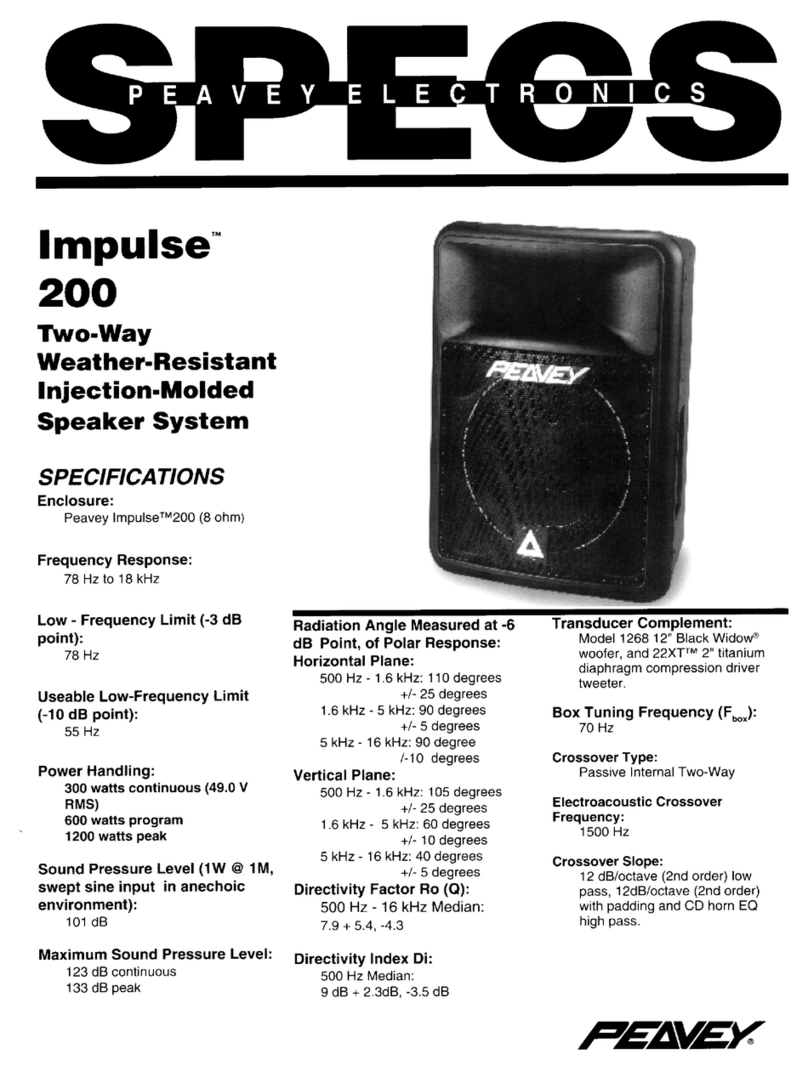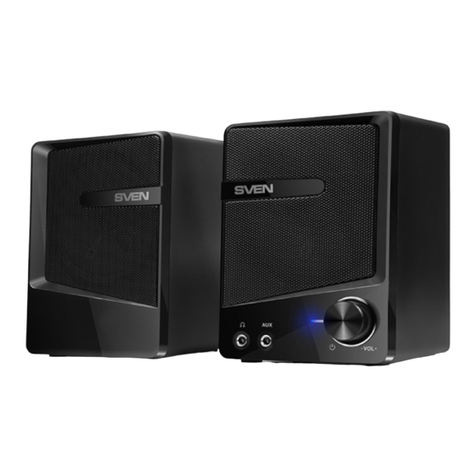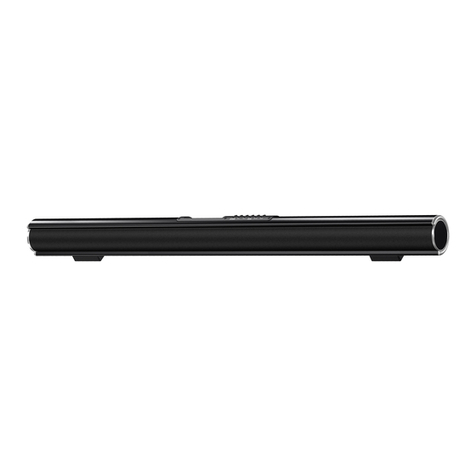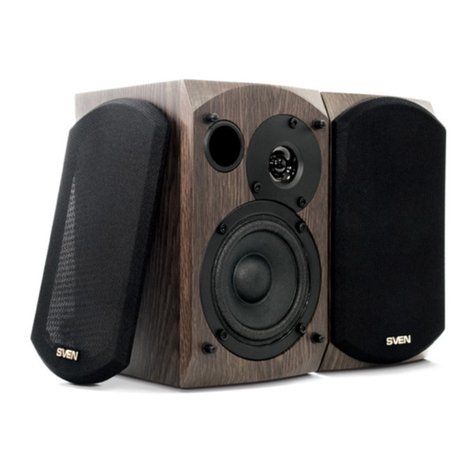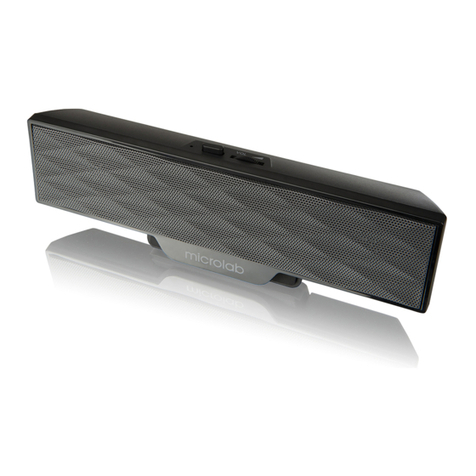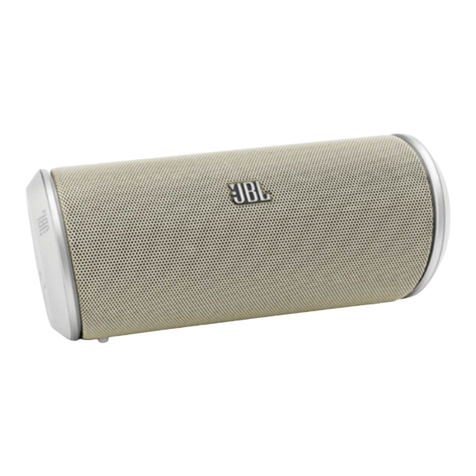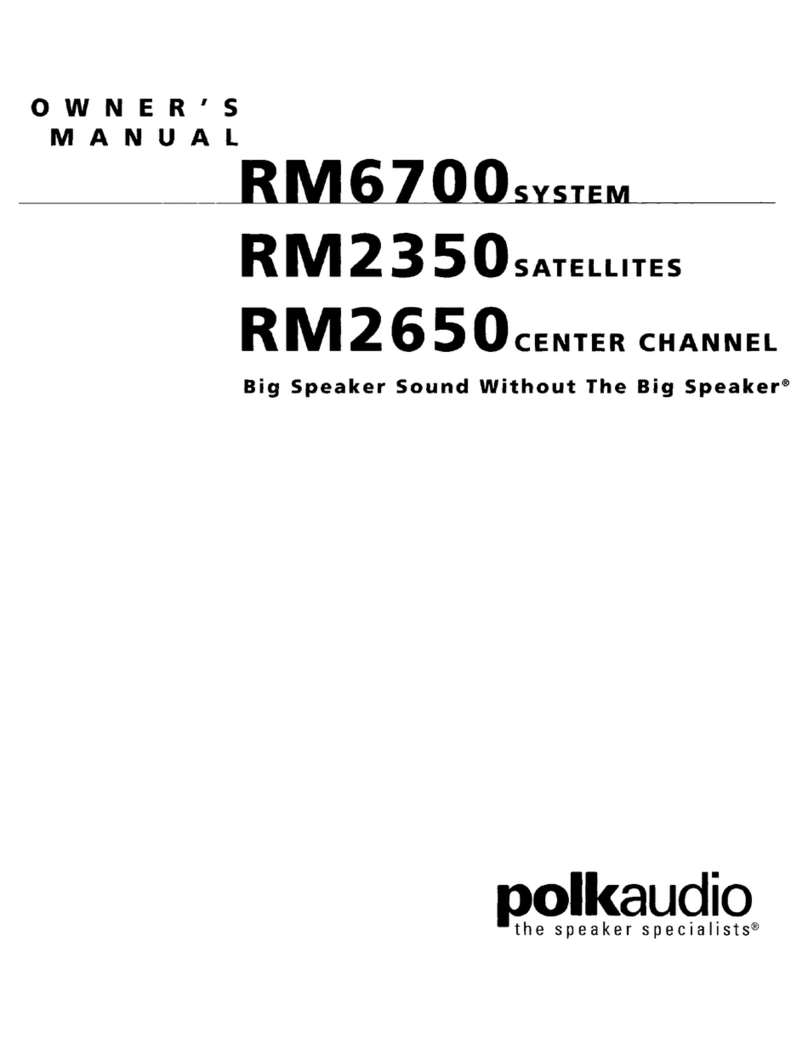EMPHASER MONOLITH Series Installation instructions

MONOLITH SERIE
COMPONENT SYSTEMS
INSTALLATION & OPERATING MANUAL
EINBAU- & BEDIENUNGSANLEITUNG
ECP-M6
ECP-M4
ECP-M5
ECP-M6
ECP-M5

2 3
Congratulations!
And thank you for purchasing this high quality component system from our MONOLITH-
series. If you plan on installing the system by yourself, please read the following instructions
carefully before you attempt the installation. For any further information about this product,
please contact your authorized EMPHASER dealer.
ABOUT THIS LOUDSPEAKER SYSTEM
All components of this MONOLITH system have been carefully selected and precisely matched.
The Aluminum membrane of the woofers is due to its hardness and the high natural resonance
frequency ideally suited for a detailed and extremely low-distortion reproduction quality in the
intended area of application. The 25 mm silk dome tweeter convinces with its warm sound
and the ability to produce even the finest musical details. At the heart of the systems are the
elaborately designed crossovers: the parts have been defined in intensive test series in the
laboratory as well as in the vehicle, with the aim of achieving the best possible phasing of
the tweeters and woofers in the crossover frequency band. The result is immersive musical
enjoyment with vivid natural voices and instruments and their positioning on the imaginary
soundstage as well as an impressive spatial depth. EMPHASER wishes you a lot of fun with
this outstanding speaker system.
Key Feature Woofer
■ Aluminum Diecast-basket with optimized temperature management
■ Strontium-Ferrite magnet motor
■ Aluminum cone with inverted Aluminum dust cap
■ ECP-M4 and ECP-M5 with Butyl-rubber surround
■ ECP-M6 with M-shape Butyl-rubber surround for low distortion at high cone excursion
■ Two layer copper voice-coil, wound on temperature resistant and electrically neutral
Polyimide voice-coil former
■ Long-living Connex-spider with woven tinsel leads
■ Gold-plated screw terminal
Key Features Tweeter
■ 25 mm silk dome
■ Neodymium magnet motor
■ CNC-milled Aluminum-housing with low mounting depth
■ Grill with large hexagon holes for high sound permeability and low reflection
■ Mounting housing for the installation in two angles
Key Features Crossovers
■ Separated crossover housings for tweeter and woofer for convenient installation.
Secondly, there is no mutual interference between the two signal paths due to
components that are too close together
■ Use of high quality air coils, MKP capacitors and MOX resistors in the direct signal path
■ ECP-M6 and ECP-M5 with 12 / 12 dB filter slope
■ ECP-M4 with 12 / 6 dB filter slope
■ Three-level tweeter volume attenuation
Box Content
■ 2x Woofer
■ 2x Woofer crossover
■ 2x Tweeter
■ 2x Tweeter crossover
■ 2x Mounting housing
■ 2x Speaker grilles
■ 1x Manual
MOUNTING
The first step of a successful installation is to choose the best mounting locations for the
tweeters and mid/woofers. Usually, cars come with factory speaker openings for mid/woof-
ers. If you cannot mount the mid/woofers to an existing factory cutout, the alternative is to
buy a set of car specific speaker mounting adapters, to provide a stable platform for the mid/
woofer mounting. In such a case, we recommend you consult your authorized EMPHASER
dealer to ask for his assistance.
Tweeter Mounting
The tweeter positioning does exhibit a direct and profound influence on the front staging of
your component system. Depending on the chosen location, where the tweeters are installed,
different loudness levels in the treble region will result. The installation location of the tweeters
also has an influence on the spatial representation of the system. Due to the different distances
of the sound, there can be differences in the sum of the individual sound components of the
tweeter and bass-midrange around the crossover frequency. Therefore, care should be taken
to ensure that the distances between the ear and the woofer / tweeter are approximately the
same. The tweeter level can be adjusted by a 3-way switch inside the x-over, to compensate
for different mounting locations.
■ To determine the best tweeter location, it may be necessary to carry out short listening
tests with the tweeter mounted to different locations inside the vehicle. For this, double
sided tape can be used.
■ Set all tone controls, i.e. pre-EQ, treble / bass and loudness functions of your head unit
to the neutral position first, before you attempt listening to the speakers installed in your
car.
The influence of the tweeter mounting location on the front staging is profound – and care must
be taken to achieve a good compromise between unobtrusive mounting and good sound quality.

45
Examples of different tweeter mounting locations, and the results that are most frequently
obtained, are explained below:
1. A-Pillar
Best option concerning the depth of image and overall sound balance of the
component system. It's not that easy to get right, i.e. excessive mounting effort.
2. Dash Board
Sometimes aggressive and overly brilliant treble reproduction caused by the horn
loading effects of the front window. Setting tweeter to -3 dB may help.
3. Window Triangles
Bright sound combined with a high soundstage, sometimes sounding a bit “nervous”
with side biasing.
4. On the upper end of the door panel
Balanced sound with good staging qualities, reduced sound staging and with side
biasing.
5. Right on top of the mid/woofer
“Dull” sound, especially with a person sitting on the passenger's seat.
• Attention: The main radiation axis of both tweeters should cross at a virtual point approx.
in the center between front of passenger and driver’s seat. A direct “on-axis” installation of
the tweeters, where they aim or point at the listener, is not recommended. The result of tweet-
ers aiming too much in direction of the listener is called “side-biasing”. The sound seems to
originate from the left front door instead of playing in the center of the dash board!
Angled mounting of the Tweeter
The tweeter mounting adapter provides two bearing surfaces with two possible radiation
angles. Inside the adapter you can spot two areas with implied holes for the cable and the
fixing screws. Chose the area you want the way to mount the adapter and drill out the holes
completely: 6 mm for the cable and 2.5 mm for the screws. Mark the location where you are
going to mount the tweeters. Use the mounting adapter as a template and mark the holes
with a 6 mm diameter for the cables and two 2.5 mm holes for the screws. Drill the holes and
mount the adapter with two screws. Feed the wire through the bigger hole and connect it to
the crossover. Lock the tweeter by pushing it down into the mounting adapter.
Flush mounting of the Tweeter
After choosing the best mounting location, make sure there is at least 18 mm of clearance
behind the mounting surface (cable is not taken into account!), before you start to mark or cut
anything! Cut a hole with exactly 44 mm diameter into the mounting surface using a power
drill and a circle cutter tool. Lock the tweeter by pushing it down into the hole. To definitely
secure the tweeter in the hole you can fix it with hot glue or adhesive Butyl tape from behind.
Attach the wire to the crossover.
Crossover mounting and connection
Find a suitable mounting location for the crossovers. For example, the crossovers can be
installed in an existing cavity behind the door panel or below the dashboard. It is advanta-
geous for adjustment work if the crossovers remain easily accessible. Connect the cables
from the tweeters and woofers and from the amplifier to the respective crossovers: the tweeter
crossover is marked with TW +/- IN and TW +/- OUT, the woofer crossover is marked with
WF +/- IN and WF +/- OUT.
Observe the polarities indicated and make sure that everything has been connected correctly.
All speaker cables must be connected to the crossover with correct polarity, i.e. plus to plus,
minus to minus. The sound quality of speakers with the wrong polarity is often dramatically
poor. Missing bass, squawky midrange or extremely diffuse sound are the result of uninten-
tional polarity reversal of the cables.
Pro advice: Even if the electrical phase of the speakers is correct, i.e. according to the con-
nection diagram, the resulting acoustic phase can deviate from the desired result depending
on the installation location and tweeter orientation. Therefore, you should definitely try whether
reversing the polarity of BOTH tweeters leads to a more harmonious sound with better depth
of soundstage.
Cable cross section
If longer distances from the amplifier to the crossovers have to be overcome, use good quality
speaker cables with a minimum cross section of 2.5 mm². Failure to do so will affect sound
quality in a negative way.
Crossover adjustments
Finally, the tweeter level is adjusted to the given vehicle acoustics and your own taste. This
volume level adjustment takes place via slide switch in the crossover and may also be changed
later after the system has run in.
+3 dB if the tweeter is at a significantly higher distance from the woofer or the installation
location severely limits the level of the tweeter, e.g. in the footwell
0 dB position is usually the setting that provides a good tonal balance for most installs. It is
recommended for the most tweeter positions.
-3 dB as a general rule of thumb, this position is best for tweeters that are mounted very close
to the listener’s head like window triangles or top of the door panels.
• Attention: The tweeter attenuation must be chosen identically on both crossovers. After
completing the settings of tweeter attenuation and polarity, you can mount the crossover in
place and reinstall all the other panels / factory grilles a.s.o. Your installation is now complete
and therefore ready, to be checked out.
ECP-M4: The mounting locations of the components for a 10 cm system can be significantly
different than with a classic 13 or 16.5 cm system, in which the woofer is usually to be installed
in the footwell. The M4 tweeter crossover therefore offers another jumper: Select "Short
distance" if the tweeter is placed near the midrange, for example both components in the door.
"Long Distance" is recommended for higher distances from approx. 30 cm (i.e. midrange in
the door, tweeter in the A-pillar).
Testing of the installed system
Slowly turn up the volume of your head unit and listen for distorted sounds. If everything ap-
pears to be okay and it just sounds right, check out the speaker balance of the left and right
side by adjusting the balance control of your head unit. Shifting the balance to the left channel
should provide you with sounds coming solely from the left speaker system, while shifting
the balance to the right should do the same for the right speakers. If anything appears to be
wrong, you must recheck the wiring of the x-overs, the amp or the mid/woofers.

67
Herzlichen Glückwunsch!
Wir danken Ihnen, dass Sie sich zum Kauf dieses hochwertigen Komponentensystems aus
unserer MONOLITH-Serie entschieden haben. Falls Sie beabsichtigen, das System selbst
einzubauen, bitten wir Sie, sich eingehend mit den nachfolgend im Detail beschriebenen
Montage- und Einstellmöglichkeiten dieses Lautsprechersets vertraut zu machen. Falls Sie
weitere Fragen zu diesem Produkt haben, lassen Sie sich von Ihrem EMPHASER Fachhändler
beraten.
ÜBER DIESES LAUTSPRECHERSYSTEM
Alle Komponenten dieses MONOLITH Systems wurden sorgfältig ausgewählt und präzise
aufeinander abgestimmt. Die Aluminium-Membran der Tieftöner ist aufgrund ihrer Härte
und der hohen Eigenresonanzfrequenz bestens geeignet für die detailreiche und äusserst
verzerrungsarme Wiedergabequalität im vorgesehenen Einsatzbereich. Der 25 mm Hoch-
töner mit Gewebekalotte überzeugt mit seinem warmen Klangbild und der Fähigkeit, selbst
kleinste Musikdetails hervorzubringen. Herzstück der Systeme sind die aufwendig gestal-
teten Frequenzweichen: die Bauteile sind unter intensiven Testreihen im Labor sowie auch
im Fahrzeug definiert worden, mit dem Ziel einer bestmöglichen Phasenlage von Hoch- und
Tieftöner im Übernahmebereich. Das Ergebnis ist ein immersiver Musikgenuss mit plastischen
Stimmen und Instrumenten und deren Positionierung auf der imaginären Bühne sowie einer
beeindruckenden Raumtiefe. EMPHASER wünscht Ihnen viel Freude mit diesem herausra-
genden Lautsprechersystem.
Hauptmerkmale Tieftöner
■ Aluminium Druckguss-Korb mit optimiertem Temperaturmanagement
■ Strontium-Ferrit Magnet
■ Aluminium Membran mit inverser Aluminium Dustcap
■ ECP-M4 und ECP-M5 mit Butyl-Gummi-Sicke
■ ECP-M6 mit Butyl-Gummi-Sicke im M-Design für geringe Verzerrungen auch bei hohen
Auslenkungen
■ Zweilagige Kupferdraht-Schwingspule, gewickelt auf einen temperaturfesten und
elektrisch neutralen Polyimid Schwingspulenträger
■ Langlebige Connex-Zentrierspinne mit eingewebter Schwingspulenzuleitung
■ Vergoldetes Schraubterminal
Hauptmerkmale Hochtöner
■ 25 mm Gewebekalotte
■ Neodym Magnet
■ CNC-gefrästes Aluminium-Gehäuse mit geringer Einbautiefe
■ Schutzgitter mit sehr grosser Öffnungsfläche für hohe Schalldurchlässigkeit und
geringen Reflexionen
■ Aufbaugehäuse für die Montage in zwei verschiedenen Abstrahlwinkeln
Hauptmerkmale Frequenzweichen
■ Getrennte Weichengehäuse für Hochton und Tiefton für bestmöglichen
Montagekomfort. Ebenfalls findet keine gegenseitige Beeinflussung der beiden
Signalwege durch zu eng aneinander liegende Bauteile statt
■ Verwendung von hochwertigen Luftspulen, MKP Kondensatoren und MOX-
Widerständen im direkten Signalweg
■ ECP-M6 und ECP-M5 mit 12 dB Tieftöner / 12 dB Hochtöner Filter
■ ECP-M4 mit 12 dB Tieftöner / 6 dB Hochtöner Filter
■ Drei-stufige Pegelanpassung für den Hochtöner
Lieferumfang
■ 2x Tiefmitteltöner
■ 2x Tieftöner Frequenzweiche
■ 2x Hochtöner
■ 2x Hochtöner Frequenzweiche
■ 2x Aufbaugehäuse
■ 2x Lautsprechergitter
■ 1x Bedienungsanleitung
MONTAGE
Der erste Schritt einer erfolgreichen Installation ist, die akustisch optimalen Einbauplätze
auszuwählen. Berücksichtigen Sie für die Montage der Tiefmitteltöner die vom Hersteller des
Fahrzeugs vorgesehenen Einbauplätze oder besorgen Sie sich ein stabiles fahrzeugspezifi-
sches Doorboard aus MDF, um die Tiefmitteltöner möglichst stabil und fest an den Vordertüren
montieren zu können. Sollten Sie ein Doorboard zur Montage des Compo-Sets in Erwägung
ziehen, lassen Sie sich von ihrem EMPHASER Fachhändler beraten!
Platzierung der Hochtöner
Die Platzierung der Hochtöner hat einen recht großen Einfluss auf das klangliche Gesamt-
resultat. Je nach Ausrichtung und der relativen Höhe des Montageplatzes der Hochtöner,
resultieren unterschiedliche Lautstärken im Hochtonbereich und es ergeben sich durch die
Richtcharakteristik der Hochtöner auch unterschiedliche Frequenzgänge. Zusätzlich hat der
Einbauor t der Hochtöner auch einen Einfluss auf die räumliche Abbildung der Systeme. Durch
die unterschiedlichen Wegstrecken des Schalls kann es zu Differenzen in der Summenbildung
der einzelnen Schallanteile von Hochtöner und Tiefmitteltöner um die Trennfrequenz herum
kommen. Daher sollte möglichst darauf geachtet werden, dass die Abstände zwischen Ohr
und Tieftöner/Hochtöner ungefähr gleich sind. Die Lautstärke der Hochtöner kann mittels
3-Wege Jumper auf der Frequenzweiche angepasst werden.
■ Um den klanglich besten Platz für die Hochtöner zu bestimmen, ist es je nach Gegeben-
heiten im Innern des Fahrzeugs sinnvoll, kurze Hörtests durchzuführen. Zu diesem Zweck
können die Hochtöner z.B. mit doppelseitigem Klebeband an den in Frage kommenden
Orten provisorisch fixiert werden.
■ Bevor Sie mit den Lautsprechern und Weicheneinstellungen von der Hochtonlautstärke
durchtesten, müssen sämtliche Klangregler an ihrem Radio in die jeweilige Neutral- oder
Nullstellung gebracht werden. Dies betrifft insbesondere EQ-Einstellungen, als auch Bass-
Höhen- und Loudness Funktionen.

89
Trotz der Anpassungsmöglichkeiten auf der Frequenzweiche ergibt sich durch die Wahl des
Montageortes der Hochtöner eine bestimmte „Klangcharakteristik“.
1. Versenkt in A-Säule (Höhe ca. Mitte Windschutzscheibe oder in Höhe der Ohren)
Meist gutes Staging und hohe Bühnenabbildung – aber auch mit hohem Einbauaufwand
verbunden.
2. Versenkt oder Aufbau - Armaturenbrett (gegen Windschutzscheibe strahlend)
Recht gutes Staging, aber manchmal diffuser Klang (schlechte Ortung) und wenn die
Hochtöner zu dicht vorne unter der Scheibe spielen oder zu laut eingepegelt sind, auch
aggressiver Hochtonbereich.
3. Versenkt im Spiegeldreieck. Heller Klang mit recht hoher Bühnenabbildung, je nach
Ausrichtung / Position und Fahrzeug aber auch nervig und unruhig.
4. Versenkt in der Türverkleidung oben. Ausgeglichener Klang, aber oft reduzierte
Räumlichkeit und stärkeres „Side Biasing“ (Klang ist seitenlastig).
5. Versenkt in der Türverkleidung unten
Im Hochtonbereich matter Klang mit diffuser Räumlichkeit, mit Beifahrer dumpf und
linkslastig.
• Anmerkung: Beide Hochtöner sollten so ausgerichtet werden, dass sich die Hauptabstrahl-
achse etwa in der Mitte zwischen den Vordersitzen kreuzt. Es ist nicht immer von Vorteil, die
Hochtöner direkt zum Hörer hin anzuwinkeln, speziell wenn man durch Gegebenheiten des
Fahrzeugs eher nahe am linken Hochtöner sitzt. Eine stabile räumliche Abbildung mit guter
Mittenortung basiert auf gleichen Wegstreckenlängen des Schalls, welche über den Einbauort
der Hochtöner maßgeblich beeinflusst werden kann.
Angewinkelte Aufbaumontage des Hochtöners
Das Aufbaugehäuse ist asymmetrisch und ermöglicht dadurch eine Montage mit zwei un-
terschiedlichen Abstrahlungswinkeln. Suchen Sie einen geeigneten Platz und richten Sie
die Gehäuse aus. Auf der Innenseite befinden sich zwei Ebenen mit angedeuteten Monta-
gelöchern. Je nach gewählter Position des angewinkelten Gehäuseadapters bohren Sie die
benötigten Löcher auf der Auflagefläche vorsichtig komplett durch: Zwei 2.5 mm Löcher für
die Befestigung mit Schrauben und ein 6 mm Loch für die Kabeldurchführung. Markieren Sie
nun mit dem Gehäuseadapter als Schablone diese drei Löcher auf der Montageoberfläche:
für die Durchführung des Kabels durch die Montageoberfläche (6 mm) und die Löcher (2.5
mm) für die Befestigung des Adapters. Nach dem Einfädeln des Hochtönerkabels durch
das Aufbaugehäuse und dem Anschluss der Kabelenden an die Frequenzweiche kann der
Gehäuseadapter mit geeigneten Schrauben festgeschraubt werden. Der Hochtöner wird nun
durch einfaches Hereindrücken in den Adapter eingerastet und fixiert.
Versenkte Montage des Hochtöners
Für die vollversenkte Montage muss eine Tiefe von mindestens 18 mm hinter der Montageober-
fläche zur Verfügung stehen (Kabel ist nicht berücksichtigt). Markieren Sie den Mittelpunkt des
Montageortes. Verwenden Sie eine Lochsäge mit exakt 44 mm Durchmesser zum Bohren der
Montageöffnung. Drücken Sie den Hochtöner vorsichtig in das Loch und fixieren Sie den Hoch-
töner auf der Rückseite mit Heisskleber oder einem Stück selbstklebender Butyl-Rundschnur.
Anschluss & Montage der Frequenzweichen
Suchen Sie einen geeigneten Montageort für die Frequenzweichen. Die Frequenzweichen
können in einem vorhandenen Hohlraum hinter der Türverkleidung oder unterhalb des
Armaturenbretts angebracht werden. Vorteilhaft ist für Einstellarbeiten zu einem späteren
Zeitpunkt, wenn die Weichen leicht zugänglich bleiben. Schließen Sie die Zuleitungskabel
von den Hoch- bzw. Tieftönern und vom Verstärker an die jeweiligen Frequenzweichen an:
die Hochtöner-Weiche ist markiert mit TW+/- IN und TW +/- OUT, Die Tieftöner-Weiche ist
gekennzeichnet mit WF +/- IN und WF +/- OUT.
Beachten Sie die angegebenen Polaritäten und vergewissern Sie sich, dass alles korrekt
angeschlossen wurde. Alle Lautsprecherkabel müssen mit korrekter Polung an der Frequenz-
weiche angeschlossen werden, d.h. Plus auf Plus, Minus auf Minus. Die Wiedergabequalität
von verpolt angeschlossenen Lautsprechern ist oft dramatisch schlecht. Fehlender Bass,
quäkige Mitten oder extrem diffuser Klang sind die Folge von unbeabsichtigtem Verpolen
von Zuleitungskabeln.
Profi Tipp: Auch wenn die elektrische Phase der Lautsprecher korrekt ist, also gemäss
Anschlussschema, kann je nach Montageort und Hochtöner-Ausrichtung die resultierende
akustische Phase vom gewünschten Ergebnis abweichen. Daher sollte man ausprobieren, ob
ein Verpolen BEIDER Hochtöner zu einem harmonischeren Klangbild mit mehr Raumtiefe führt.
Kabelquerschnitt
Sofern längere Zuleitungswege zur Frequenzweiche zu überbrücken sind, z.B. wenn sich
die Endstufe im Kofferraum befindet, sollten Sie unbedingt auf einen ausreichend hohen
Querschnitt der Lautsprecherkabel achten. 2,5 mm² Lautsprecherkabel-Querschnitt sind
hier notwendig, dünnere Kabel verschlechtern den Klang hörbar.
Einstellungen an der Frequenzweiche
Abschließend erfolgt die Anpassung des Hochtonpegels an die gegebene Fahrzeugakustik
und den eigenen Geschmack. Diese Pegelanpassung erfolgt über einen Jumper in der
Frequenzweiche und darf auch später nach dem Einlaufen der Systeme verändert werden.
+3 dB, wenn sich der Hochtöner in einer deutlich höheren Distanz zum Tieftöner befindet oder
der Montageort den Pegel des Hochtöners stark einschränkt, z.B. im Fussraum.
0 dB, Ausgewogene Stellung, geeignet für die meisten Einbaupositionen. Diese Position sollte
bei den meisten Anwendungen sehr ausgewogene Klangresultate erzielen.
-3 dB, Wenn ein eher leiser Hochtonbereich erwünscht ist oder sich der Hochtöner sehr nahe
am Ohr bzw. in kürzerer Distanz zum Tieftöner befindet.
• Achtung: Auf beiden Frequenzweichen muss der Jumper für den Hochtonpegel in glei-
cher Stellung gesetzt werden! Nach erfolgter Pegeleinstellung kann die Frequenzweiche am
vorgesehenen Ort befestigt werden. Danach können alle Abdeckungen, Türverkleidungen
etc. wieder montiert werden. Der Einbau ist beendet.
ECP-M4: Die Montageorte der Komponenten können für ein 10 cm System deutlich unter-
schiedlicher sein, als bei einem klassischen 13 oder 16.5 cm System, bei denen der Tieftöner
in der Regel im Fußraum zu montieren ist. Daher bietet die M4 Hochton-Frequenzweiche einen
weiteren Jumper an: „Short distance“ wählen, wenn der Hochtöner in der Nähe des Mitteltöners
platziert ist, zum Beispiel beide Komponenten in der Tür. „Long Distance“ ist empfehlenswert
für höhere Abstände ab ca. 30 cm (z.B. Mitteltöner in der Tür, Hochtöner in der A-Säule).
Inbetriebnahme des Systems
Schalten Sie Ihr Radio ein und erhöhen Sie langsam die Lautstärke. Achten Sie auf erhöhte
Verzerrungen oder Störgeräusche. Wenn dies der Fall sein sollte, müssen Sie Ihren Einbau
nochmals genau überprüfen, im speziellen die Polaritäten der Anschlüsse am Verstärker und
an den Frequenzweichen.

10 11
EMPHASER LIMITED WARRANTY
Dear customer
Keep the original packing for later use and read the warranty specifications below carefully.
Should your EMPHASER product require warranty service, please return it to the retailer from whom
it was purchased or the distributor in your country. Should you have difficulty in finding an authorized
EMPHASER service center, details are available from your local distributor.
This EMPHASER product is warranted against defective materials and defects caused during ma-
nufacturing for a period of two years from date of purchase, to the original purchaser. Warranty work
will not be carried out unless the warranty certificate is presented together with the original sales slip.
WARRANTY LIMITATIONS
This warranty does not cover damages due to:
1. incorrect audio or power connection(s).
2. exposure to excessive humidity, fluids, sun rays or dirt and dust.
3. damage by accidents or mechanical shock.
4. abuse, unauthorized repair attempts and modifications not explicitly authorized by the manufacturer.
This warranty is limited to the repair or the replacement of the defective product at the manufacturer’s
option and does not include any other form of damage, whether incidental, consequential or other-
wise. The warranty does not cover any transport costs or damages caused by transport or shipment
of the product.
EMPHASER GARANTIE-BESTIMMUNGEN
Sehr geehrter Kunde, sehr geehrte Kundin
Wir bitten Sie, die Originalverpackung für einen allfälligen Transport aufzuheben und die Garantie-
Bestimmungen durchzulesen.
Sollten Sie für Ihren Aktivsubwoofer Garantie-Leistungen beanspruchen, wenden Sie sich bitte direkt
an den Händler, bei dem Sie das Gerät gekauft haben.
Bei Schwierigkeiten, ein geeignetes EMPHASER Service-Center zu finden, erhalten Sie bei Ihrem
jeweiligen Landes-Vertrieb weitere Informationen.
Der Hersteller gewährleistet auf dieses EMPHASER Produkt bei Material- oder Herstellungsfehlern
zwei Jahre Garantie an den Erstkäufer, geltend ab Kaufdatum der ausgestellten Rechnung. Garantie-
Ansprüche können nur mit einer korrekt und vollständig ausgefüllten Garantie-Karte zusammen mit
dem Original-Kaufbeleg geltend gemacht werden.
GARANTIE-EINSCHRÄNKUNGEN
Nicht unter Garantie fallen Schäden infolge von:
1. inkorrekten Audio- oder Stromanschlüssen.
2. schädlichen Einwirkungen von übermäßiger Feuchtigkeit, Flüssigkeiten, Hitze, Sonneneinstrah-
lung oder starker Verschmutzung.
3. mechanischer Beschädigung durch Unfall oder Stössen.
4. Schäden durch nicht autorisierte Reparaturversuche oder nicht durch den Hersteller ausdrücklich
autorisierte Modifikationen.
Die Garantie dieses Produkts bleibt in jedem Fall auf die Reparatur bzw. den Ersatz (Entscheidung
durch Hersteller) des jeweiligen EMPHASER Produkts beschränkt. Schäden durch unsachgemäße
Verpackung und daraus resultierende Transportschäden werden nicht durch diese Garantie abge-
deckt. Jeder über diese Garantie-Erklärung hinausgehende Anspruch und jede Haftung für direkte
oder indirekte Folgeschäden werden ausdrücklich abgelehnt.
WARRANTY CARD / GARANTIEKARTE
MODEL: ❏ ECP-M6 ❏ ECP-M5 ❏ ECP-M4
Date of purchase:
Your name:
Your address:
City:
State: ZIP or Postal Code:
Country:
Your phone number:
Dealer’s address & stamp
❏ Installed by
authorized dealer
Installation date:
Inspected and
approved by:
Installation Approval
❏ Self-installed
by customer
EMPHASER
Manufacturer:
ACR, Brändli + Vögeli AG, Bohrturmweg 1, CH-5330 Bad Zurzach, Switzerland
Phone: (+41) (0)56 269 64 64, Fax: (+41) (0)56 269 64 65, mail@acr.eu, www.acr.eu
EU Legal Representative:
ACR S & V GmbH, Industriestraße 35, D-79787 Lauchringen, Germany

Rev. A
This manual suits for next models
3
Table of contents
Languages:
Other EMPHASER Speakers System manuals
